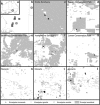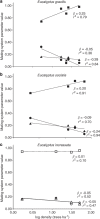Mating patterns and pollinator mobility are critical traits in forest fragmentation genetics
- PMID: 24002239
- PMCID: PMC4815446
- DOI: 10.1038/hdy.2013.48
Mating patterns and pollinator mobility are critical traits in forest fragmentation genetics
Abstract
Most woody plants are animal-pollinated, but the global problem of habitat fragmentation is changing the pollination dynamics. Consequently, the genetic diversity and fitness of the progeny of animal-pollinated woody plants sired in fragmented landscapes tend to decline due to shifts in plant-mating patterns (for example, reduced outcrossing rate, pollen diversity). However, the magnitude of this mating-pattern shift should theoretically be a function of pollinator mobility. We first test this hypothesis by exploring the mating patterns of three ecologically divergent eucalypts sampled across a habitat fragmentation gradient in southern Australia. We demonstrate increased selfing and decreased pollen diversity with increased fragmentation for two small-insect-pollinated eucalypts, but no such relationship for the mobile-bird-pollinated eucalypt. In a meta-analysis, we then show that fragmentation generally does increase selfing rates and decrease pollen diversity, and that more mobile pollinators tended to dampen these mating-pattern shifts. Together, our findings support the premise that variation in pollinator form contributes to the diversity of mating-pattern responses to habitat fragmentation.
Figures



References
-
- Aguilar R, Quesada M, Ashworth L, Herrerias-Diego Y, Lobo J. (2008). Genetic consequences of habitat fragmentation in plant populations: susceptible signals in plant traits and methodological approaches. Mol Ecol 17: 5177–5188. - PubMed
-
- Aizen MA, Feinsinger P. (1994). Habitat fragmentation, native insect pollinators, and feral honey bees in Argentine 'Chaco Serrano'. Ecol Appl 4: 378–392.
-
- Barrett SCH. (1998). The evolution of mating strategies in flowering plants. Trends Plant Sci 3: 335–341.
-
- Bianchi FJJA, Cunningham SA. (2012). Unravelling the role of mate density and sex ratio in competition for pollen. Oikos 121: 219–227.
-
- Bond HW, Brown WL. (1979). The exploitation of floral nectar in Eucalyptus incrassata by honeyeaters and honeybees. Oecologia 44: 105–111. - PubMed
Publication types
MeSH terms
Associated data
LinkOut - more resources
Full Text Sources
Other Literature Sources

